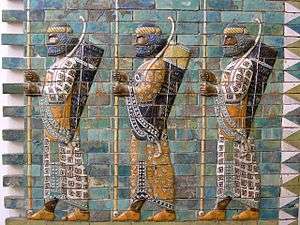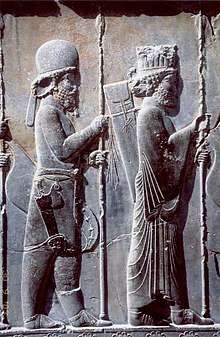Immortals (Achaemenid Empire)
The Immortals (Ancient Greek: Ἀθάνατοι Athánatoi) also known as the Persian Immortals was the name given by Herodotus to an elite heavily-armed infantry queued unit of 10,000 soldiers in the army of the Achaemenid Empire. This force performed the dual roles of both Imperial Guard and standing army. The force consisted mainly of Persians, but also included Medes and Elamites. Essential questions regarding the unit remain unanswered, because authoritative sources are missing.[2]

Herodotus

Herodotus describes the 'Immortals' as being heavy infantry, led by Hydarnes; it provided the professional corps of the Persian armies and was kept constantly at a strength of exactly 10,000 men. He stated that the unit's name stemmed from the custom that every killed, seriously wounded, or sick member was immediately replaced with a new one, maintaining the corps as a cohesive entity with a constant strength.[3]
The Persian denomination of the unit is uncertain.[4] This elite corps is only called the 'Immortals' in sources based on Herodotus. There is evidence of the existence of a permanent corps from Persian sources, which provided a backbone for the tribal levies who made up the bulk of the Achaemenid armies. These do not however record the name of "Immortals". It is suggested that Herodotus' informant has confused the word anûšiya- ("companion") with anauša- ("immortal"),[3] but this theory has been criticized by Rudiger Schmidt.[2]
History
The Immortals played an important role in Cambyses II's conquest of Egypt in 525 BC and Darius I's invasion of ancient India's smaller western frontier kingdoms (western Punjab and Sindh, now in Pakistan) and Scythia in 520 BC and 513 BC. Immortals participated in the Battle of Thermopylae 480 BC and were amongst the Persian occupation troops in Greece in 479 BC under Mardonius.[3]
During the final decades of the Achaemenid empire, the role expected of the hazarapatish (commanding officer) of the Immortals was extended to include that of chief minister to the king.[5] The provision of a bodyguard, in direct attendance on the monarch, had already been allocated to a select thousand strong detachment of the corps.[5]
Equipment

Xenophon (Cyropaedia 6.4.1; 7.1.2) describes the guard of Cyrus the Great as having bronze breastplates and helmets, while their horses wore bronze chamfrons and peitrels together with shoulder pieces which also protected the rider’s thighs. Herodotus, instead, describes their armament as follows: wicker shields covered in leather, short spears, quivers, swords or large daggers, slings, bow and arrow. Underneath their robes they wore scale armour coats. The spear counterbalances of the common soldiery were of silver; to differentiate commanding ranks, the officers' spear butt-spikes were golden.[3] The regiment was followed by a caravan of covered carriages, camels, and mules that transported their supplies, along with concubines and attendants to serve them; this supply train carried special food that was reserved only for their consumption.[6][7]
The headdress worn by the Immortals is believed to have been the Persian tiara. Its actual form is uncertain, but some sources describe it as a cloth or felt cap which could be pulled over the face to keep out wind and dust in the arid Persian plains.[3] Surviving Achaemenid colored glazed bricks and carved reliefs represent the Immortals as wearing elaborate robes, hoop earrings and gold jewelry, though these garments and accessories were most likely worn only for ceremonial occasions.[8]
Legacy
Sassanid Empire
The first reoccurrence of the word "Immortals" is in Roman historians' description of an elite cavalry unit of the army of the Sasanian Empire. Primary sources suggest that they were numbered 10,000 men, with the difference that they were heavy cavalry. However, recent scholarship has doubted that the Roman description of the force, including their name, their size, and that they were modeled on the Achaemenid Immortals, although there may have been one or more of such distinct elite cavalry units in the Sasanian period. Their task was mainly to secure any breakthroughs and to enter battles at crucial stages.[9]
Byzantine Empire
The designation "Immortal" to describe a military unit was used twice during the Byzantine Empire, first as elite heavy cavalry under John I Tzimiskes (r. 969–976) and then later by Nikephoritzes, the chief minister of Emperor Michael VII (r. 1071–1081), as the core of a new central field army, following the disastrous defeat of Manzikert by the Seljuk Turks in 1071.
French Empire
Many centuries later, during the Napoleonic Wars, French soldiers referred to Napoleon's Imperial Guard as "the Immortals".[10]
Imperial State of Iran
The Iranian Army under the last Shahanshah included an all volunteer Javidan Guard, also known as the "Immortals" after the ancient Persian royal guard. The "Immortals" were based in the Lavizan Barracks in Tehran. By 1978 this elite force comprised a brigade of 4,000–5,000 men, including a battalion of Chieftain tanks. Following the Iranian Revolution of 1979 the "Immortals" were disbanded.[11]
The signature shield of the Achaemenid Immortals has been adopted in the insignia of the 65th Airborne Special Forces Brigade and 55th Airborne Brigade of the modern Iranian Army.
In popular culture
Herodotus' account of two warrior elites - the Spartan hoplites and the Immortals - facing each other in battle has inspired a set of rather colorful depictions of the battle, especially in regard of the Immortals:
- In the 1962 film The 300 Spartans the Immortals carry a spear and wicker shields like the actual Immortals. However, they are mostly dressed in black and other dark colors, as opposed to historical depictions.[11]
- Frank Miller's 1998 comic book 300, and the 2006 feature film adapted from it, present a heavily fictionalized version of the Immortals at the Battle of Thermopylae. These Immortals wear Mengu-style metal masks, appear to be inhuman or disfigured, and carry a pair of swords closely resembling Japanese wakizashis.[11]
- The History Channel documentary Last Stand of the 300 also features the Immortals as part of the reconstruction of the Thermopylae battle. In this version, the tiara the Immortals habitually wear is depicted here as a full-face black cloth mask transparent enough to see through.[11]
References
- http://www.iranicaonline.org/articles/persepolis
- Encyclopaedia Iranica.
- Lendering 1997.
- Charles, Michael (1 January 2011). "The Sassanian immortals". Iranica Antiqua: 289–313. doi:10.2143/IA.46.0.2084423.
- Hicks 1975, p. 61.
- John Manuel Cook (1983). The Persian Empire. Schocken Books. p. 105. ISBN 978-0-8052-3846-4.
- Kaveh Farrokh (24 April 2007). Shadows in the Desert: Ancient Persia at War. Bloomsbury USA. pp. 76–. ISBN 978-1-84603-108-3.
- Volume IX, Encyclopædia Britannica, Fifteenth Edition 1983
- Charles, Michael (1 January 2011). "The Sassanian immortals". Iranica Antiqua: 289–313. doi:10.2143/IA.46.0.2084423.
- Georges Blond, La Grande Armée, trans. Marshall May (New York: Arms and Armor, 1997), 48, 103, 470
- Rastani, Nabil (27 October 2010). "The Guards of the Shahanshah, How to fight, carry weapons, ride horses and learn archery".
Sources
- Hicks, Jim (1975). The Persians. Time-Life Books.CS1 maint: ref=harv (link)
- Lendering, John (1997). ""Immortals"". Livius.CS1 maint: ref=harv (link)
- Schmitt, Rüdiger (2004). "Immortals". Encyclopaedia Iranica.